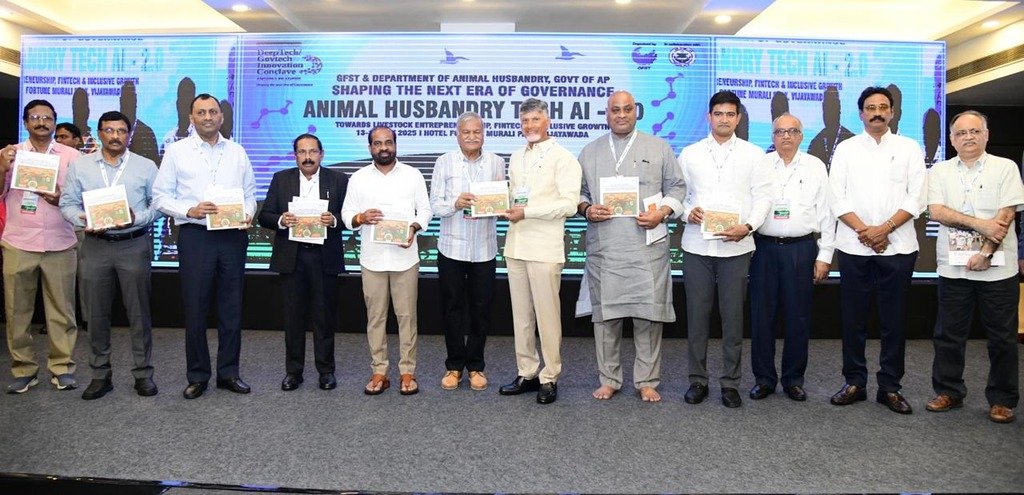The city of Vijayawada became a hub for agricultural technology and innovation on Thursday with the launch of Tech AI 2.0, a state-level initiative led by the Animal Husbandry Department. The event brought together policymakers, agri-tech startups, and department officials to explore how artificial intelligence, digital platforms, and integrated tools can strengthen livestock management and support rural livelihoods.
Organized as part of Andhra Pradesh’s broader digital development efforts, Tech AI 2.0 aimed to demonstrate practical applications of technology across the livestock sector—an area that supports nearly 42 lakh individuals across the state. The conclave served as a platform to showcase emerging tools and ideas that can streamline operations, improve farmer access to services, and contribute to sustainable growth in rural economies.
Digital Applications Take Center Stage
A major theme at the event was the need for consolidated digital support systems for farmers. Proposals discussed included a WhatsApp-based application to deliver integrated livestock services—such as veterinary care, feed supply information, disease alerts, and productivity tools—all within a single, accessible platform. The goal is to reduce barriers to service delivery while helping farmers make data-informed decisions.
Startups working at the intersection of agriculture and technology were encouraged to build user-focused tools that directly respond to the needs of farmers and livestock owners. Rather than pushing generic solutions, the emphasis was placed on developing region-specific, language-friendly, and easily deployable applications that could operate in areas with limited internet bandwidth or digital literacy.
Animal Husbandry as a Core Economic Driver
The event also highlighted the central role of the animal husbandry sector in Andhra Pradesh’s economy, contributing 13.5 percent to the state’s share of the Goods and Services Tax (GST) and approximately ₹1.69 lakh crore to the Gross State Domestic Product (GSDP). Dairy farming, in particular, was noted as a consistent income generator for rural households.
Data presented at Tech AI 2.0 pointed to a growing interest in integrating AI-based livestock monitoring, automated health tracking, and real-time farm analytics to improve yields and animal welfare. These tools, already in use in select pilot regions, were showcased as scalable solutions for wider adoption.
Building Infrastructure Around Tech and Trade
While digital tools for livestock took the spotlight, the conclave also discussed broader infrastructural developments that can complement technological progress in rural sectors. Among the key announcements was the Central Government’s approval for a shipbuilding and repair cluster at Dugarajapatnam, along with plans for a greenfield port.
These developments are expected to unlock new trade routes and enhance Andhra Pradesh’s capacity to support marine and fisheries-based industries as well. These discussions positioned tech adoption not as an isolated effort, but part of a multi-sector growth strategy where digital agriculture and modern maritime infrastructure can jointly contribute to rural employment and economic diversification.
Also read: 10 Farmer Focused Government Schemes Helping Shape India’s Agrotech Landscape
Evolving Food Systems and Farmer Preferences
Another aspect discussed at the event was the changing dietary preferences in the state and how this is reshaping demand for certain crops and livestock products. There is a noticeable shift toward protein-rich and millet-based diets, which opens up new avenues for farmers to diversify their production.
In this context, Andhra Pradesh’s leadership in micro-irrigation systems was noted as a critical enabler for diversified farming. Efficient water management, combined with better access to market information and digital advisory services, is creating space for more resilient farming systems.
Bridging Gaps Between Innovation and Implementation
A recurring point of discussion at Tech AI 2.0 was the need to bridge the gap between innovation and grassroots adoption. While technology is evolving rapidly, its real impact depends on how effectively it can be translated into local languages, customized for varying scales of operation, and integrated into existing farming practices without overwhelming users.
To address this, experts at the conclave called for collaborative efforts between government departments, academic institutions, and the private sector. Capacity-building programs, especially for women and smallholder farmers, were identified as a crucial next step in making digital agriculture truly inclusive.
Tech AI 2.0 concluded with a clear takeaway: technology in agriculture and animal husbandry is no longer optional—it is essential. From improving supply chain transparency to supporting livestock health through predictive tools, the role of digital solutions is expanding rapidly.
While challenges remain—especially in terms of adoption, affordability, and connectivity—events like Tech AI 2.0 are building the momentum needed to align innovation with everyday agricultural realities. The conclave didn’t just showcase tools; it sparked conversations about what a truly connected and responsive rural support system could look like in the coming years.


